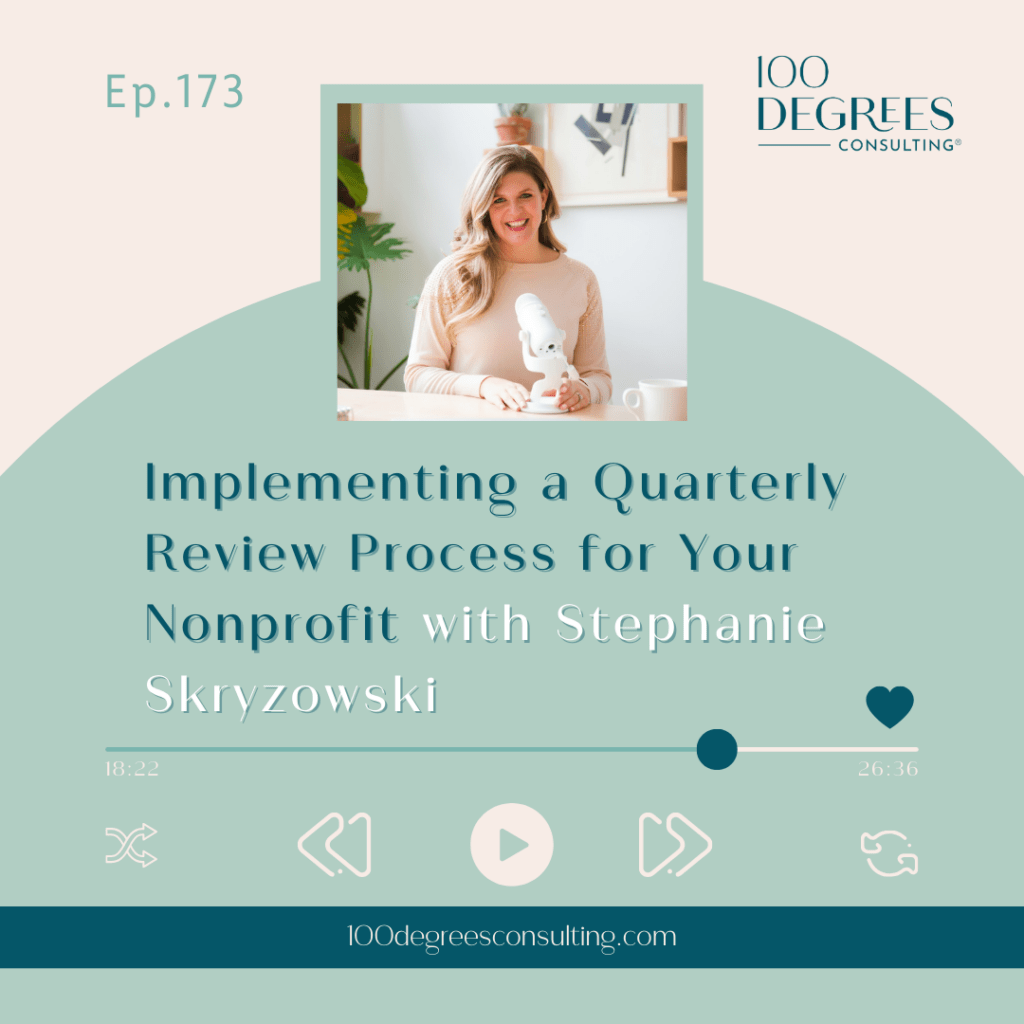Transcript for Episode 5 How to Create a Monthly Finance Routine
Stephanie Skryzowski: Welcome to the 100 Degrees of Entrepreneurship podcast. The show for purpose-driven entrepreneurs who want to get inspired to step outside of your comfort zone, expand it to your purpose, and grow your business in a big way. I’m your host, Stephanie Skryzowski, a globe-trotting CFO, whose mission is to empower leaders to better understand their numbers to grow their impact and their income. Let’s dive in.
Hello, hello, my friends. I am so excited for this episode today because I really think it’s going to help a lot of people. So today on the 100 Degrees of Entrepreneurship podcast we are talking about your monthly finance routine. Okay. Stick with me before you run away and think, “Oh, my gosh, I hate routines. I hate finance. I hate numbers. I’m going to hate every single piece of this.” No, you won’t. I promise. I absolutely promise. So I think we all know that where your attention goes, the energy flows. And I think we all want to put more energy into our numbers, right? We want more energy to come to our money, basically. We want to help increase that and increase our abundance and our wealth. And the only way to do that is to pay attention to our money.
One of the things that we do with all of our clients is we get into a solid, like rock-solid monthly finance routine. And there are a couple things that we do every single month. We do not ever skip a month. We do it every single month for both my business and for our clients to make sure that we are staying on top of our numbers, that we are using them to tell the story of our business, how our business is doing, and to make better decisions to actually achieve our goals. So if you’re listening to this, at the beginning of the year when this is launching, you may have set a goal this year to stay on top of your numbers. You may have set a goal that this is the year that you’re actually finally going to hit that big revenue goal. Or this is the year that you are finally going to pay off all that debt. Or this is a year that you’re finally going to take a salary in your business.
So there’s a lot, right? There’s a lot that we can do with our business numbers, but you have to dedicate some attention to it. And so, if that’s you, if this is going to be your year for something related to your money, this is 100% the episode for you. Today we’re talking about how to create a monthly finance routine. So what do we do? What should we even be looking at every single month when it comes to our numbers and how do we get into that flow? So, first of all, I want to talk a little bit about what’s the point? What is the point of having a monthly finance routine?
Well, first of all, like I said, I think the number one most important thing is where your attention goes, the energy flows. We want our money to grow, we want our money to flow, so let’s put our attention there, okay? That is number one. But this also helps you make decisions for your business in a very timely fashion, right? If we know exactly three days after the end of the month, what happens last month and we have this forecast looking into the future of our business, we can make really good decisions really quickly. So if you’re the type of person that sort of agonizes over different decisions you have to make in your business, because you’re just not sure, like, “Is this the thing? Do I do this? Can I afford it?” Getting into this monthly finance routine is going to answer that question for you, okay? So that piece is super, super important. And then, as part of our monthly finance routine, which I’m going to explain to you, you have a crystal ball into the future of your business. You can literally see as far out as you forecast this.
So we have some clients that we’ve actually created a 10-year vision for their business that includes numbers. So it’s not just like, “Oh, in 10 years, I want to make $10 million and I want to be doing X, Y, Z projects.” No. We have the roadmap to actually get them there. So this is going to give you insight into the future, which, that’s kind of priceless, right? What other process can give you a vision into the future that is like black and white, crystal clear with numbers? If you’re not convinced yet, rewind a little bit and listen again, but where your attention goes, the energy flows. That is why we need to create this monthly finance routine.
Before we dive right in, I first want to make sure that you have sort of set the foundation for your business financial management like you can kind of check all these boxes. Are you registered as a business? Do you have separate business bank accounts and credit card accounts? You’re not commingling your money between your personal checking account and your business checking account. Everything’s separated. Your business is legit, and you have some sort of tracking system for your revenue and your expenses. Now, this can be QuickBooks Online. That’s what we use for all of our clients. That’s what I love to recommend. It could be Xero. It could be Wave. It could be a spreadsheet. I do not care what it is, but you have a system for tracking your revenue and expenses, okay?
So those are the three prerequisites. Before we actually get started in your monthly finance routine, you need to be a legit business registered with the IRS, with the state. Number two, you need to have separate business bank accounts, no mixing up funds with your personal grocery money and your mortgage and all that good stuff, separate accounts. And number three, you have to have a system for tracking revenue and expenses every single month. I don’t care what it is as long as it’s one that you’re going to use, okay? Those are the prerequisites for our monthly finance routine.
So first of all, we want to make sure that we are tracking our revenue and expenses in a timely manner. We do not want to be in December looking at revenue and expenses from February and trying to figure out what in the world you bought from Amazon in February and how to quote that. Okay. We want to do this every single month. So this should be done within the first week or so of the next month. For example, the first week of March, you should be looking at all of your numbers from February. We want to make sure we’re not missing anything. This should be all inclusive and your bank accounts especially need to be reconciled. So that is just the process of making sure that what’s in your bank account is the same as what is in your accounting system or whatever tracking system you’re using, okay? We want to make sure we’re not forgetting anything.
So you probably all heard the saying, “garbage in, garbage out.” That means if we have bad data or incomplete or sloppy or late data going in, we’re going to get garbage out. We’re not going to get good numbers to look at every single month. So, this whole monthly finance routine conversation is pretty pointless if we don’t have good data going in. I guess that’s sort of another prerequisite. All right. So once you can ensure that you’ve got the foundation settled, you’ve got good numbers, you’re basically caught up, then we can get into your monthly finance routine.
There are three steps in our monthly finance routine. The first is your book keeping, just getting your bookkeeping done, whether you’re doing it or someone else is doing it. This should be done usually within the first week or so following the end of the month. So again, February 28th is the last day of February, between March 1st and March 7th or 10th, somewhere around there, you should have February numbers done. The first step of your monthly finance routine is getting the bookkeeping done. Again, the key is that it’s timely, it includes every transaction for the month and it’s reconciled. So we know we check that first box. We can move on to step number two, okay? Bookkeeping is number one. It’s done. It’s clean. It’s ready to look at. The next piece of your monthly finance routine is reviewing your financial reports. Okay, before you runaway because things are getting a little complicated, I promise that they’re not actually getting complicated.
Okay. We want to review our financials. And what are we reviewing here? I like to review two different reports, okay? Let’s just start there. There’s a lot more. There’s a lot of metrics that I’m a really excited to share with you, but I want to keep things super clean and super simple, so we’re going to talk about two today. You’re reviewing your financials at step number two. Now 2A, I want you to look at your comparative P&L. Any accounting system that you’re using, I always say QuickBooks Online because that’s what we use for 99% of our clients. And so, QuickBooks Online is sort of the gold standard. That’s what everybody knows and understands in our world. But just know that if you’re using Xero or if you’re using Wave or you’re using a spreadsheet, that’s fine. It does not have to be QuickBooks Online. And just know, I’m sort of talking about them all as the same thing.
So you run your comparative P&L from QBO, and look at last month compared to maybe the month prior or maybe the same month last year. Why I want you to look at a comparison is because that is going to give us a good idea of how well we’re doing, right? So if we’re comparing last month to maybe the month before, we can see if last month was a good month or a bad month for us. If we look at it sort of all by itself, not compared to anything, it’s very hard to know like, “Oh, was last month a good one? I guess it kind of felt good, but I’m not really sure.” So you need that comparative piece. That piece is really important.
So you’re looking at your P&L and you are looking at any variances. Any differences between the two months that you’re comparing, “Where are the biggest variances? Is revenue going up or down? Are expenses going up or down?” That piece is really interesting because once your eyes are not glazing over looking at your P&L, you’re kind of digging into the line items and you can ask yourself some questions like, “Oh, I thought my coaching program is doing pretty good, but when I look at the revenue, oh, it’s actually decreased a little bit. Okay, what’s going on there?” And so, when you slow yourself down a little bit, and you have set aside this dedicated time for your monthly finance routine, and again, I’m talking like an hour here, you can ask yourself these questions. You’ve got a little bit of space to slow down, look at the numbers, ask the questions and figure out what you might need to do to change that.
So the other thing I like to look at on your P&L is your profit margin. And my friends, I get the question all the time, “What’s a good profit margin?” And I hate to say, “But it depends.” It totally depends on your industry, on the size of your business. Oftentimes, as you get bigger and bigger and bigger, your profit margin which is shown in a percentage is going down a little bit but your actual net income, like the dollar amount is greater. It depends if you have a small service business or an agency versus you are manufacturing products to sell. Your profit margin is going to be different. But, the most important piece is really to compare your profit margin against yourself. So that’s another reason that you want to be looking at a P&L for last month compared to the month prior. So then you can see, “Oh, my profit margin last month was 40%, but the month prior, it was only 20%. Okay. What happened? What was different?” So again, you’re slowing down. As part of your monthly finance routine, you’re asking yourself these questions.
The second financial report to review in this piece of your finance routine is your balance sheet. I love looking at the balance sheet because it tells us how much money we have in the bank. That piece is so important. It’s really important to know how much money in the bank because we can do a little bit of a fun calculation and see how many months of cash on hand we have. And what that means is how many months could your business operate if not another dollar came in the door. And that is an important thing to know.
I think in the beginning of the pandemic, everybody wanted to know like, “Oh, my goodness. How long could I keep paying my bills and myself and my team if my income just completely dries up?” And so your balance sheet shows your cash balance on the top. That will give you that answer. So you just take your cash balance divided by your average monthly expenses. And that tells you about how many months you could operate at the exact same level if revenue just completely stopped. That’s why I like looking at the balance sheet.
So we talked about doing your bookkeeping, doing it on time, making sure you’re doing it within that first week of the month. And then, we talked about looking at two financial reports. And just slowly going through looking at different variances, how things are changing, maybe calculating a couple very simple metrics and just slowing down to ask yourself those questions. “What is going on in my business? What story are my numbers telling me?” Now, you, 100% do not need to be a CPA, an accountant, a bookkeeper, a CFO. You don’t have to be that person to be able to do this, okay? It’s really just slowing down, looking at your numbers and asking yourself questions on variances and using that information, maybe even journaling through it. If you’re really big into journaling, maybe this is something that you can incorporate into your monthly finance routine. Like, “What am I kind of getting? What is the story my numbers are telling?” Write that down. And that might give you some ideas on how to proceed after.
You hear me talk all the time about how important it is to know your numbers as a business owner, but you may be thinking, “Well, how in the world do I do that? Where do I even begin?” So I have a free resource for you. The Profit Playbook is an amazing template that you spend about 15 minutes getting it all set up, and you can literally see into the future of your business, revenue, expenses, cashflow, just like a crystal ball. It is a huge resource that will absolutely help you create a roadmap to reach your goals in your business. It is for free over at 100degreesconsulting.com/profit.
Okay. So that’s the second piece. The third piece is to forecast your future. This is the third piece of your monthly finance routine. So bookkeeping, looking at your reports and then forecasting your future. The way I like to look at it is, looking at your financial reports, looking at your P&L is like looking back in time, right? That’s history. That is what has already happened and we can’t change it at this point. We can change the future, but we can’t change what has already happened. We can make better decisions. We can make different choices, but we can’t change what’s already happened. So I like to spend time there because the past informs the future, but, forecasting is really the fun part of your monthly finance routine because this is the visionary part. This is where you have the power to do really whatever you want.
So, we really encourage all of our clients to map out the next 12 to 18 months in their business in terms of revenue, expenses, and cash flow. And we have a super handy template that can actually help you do that. If you want to do that as well, if you go to 100degreesconsulting.com/profit, you can actually grab that template, grab your Profit Playbook as what we call it. And that helps you map out your revenue, your expenses, and your cashflow. So you will know once you have this all done, you will be able to see 12 to 18 months into your future of your business. That’s the next piece that we do in our monthly finance routine.
After we’ve looked at the reports from the previous month, then we look into the future. And maybe since the last time you looked at your forecast, maybe things have changed a little bit. Maybe you hired somebody new in your business, and so you need to build them into the forecast. Or maybe, you know now that this particular client is not going to sign their contract and pay you in August. They’re actually going to start with you in October instead. So you can update that forecast, that future vision every single month. So every time you look at it, it’s going to be updated. It’s going to be a snapshot of what your year is going to look like, which is so cool. So if we’re sitting in March or April, I have this Profit Playbook in front of me that can show me what my 2021 is going to look like. I mean, how cool is that, right? By forecasting the future as part of this monthly routine, it also helps you make changes now in order to maybe avoid any issues in the future.
So for example, if you’ve got all of your revenue and your expenses and your cashflow mapped out and you can see like, “Ooh, boy. My September bank balance is, we’re going to be coasting into October on fumes.” Instead of getting to the end of September and coasting in on fumes and being totally freaked out because, “Oh, my goodness. How are we going to make payroll? How are you going to pay yourself? How are you going to pay your bills that month?” Instead of being totally freaked out then, if it’s April right now, “Okay. Well, what can we do to bring in more money or maybe trim some expenses before then so that doesn’t even happen,” right? You have this future visibility so that you can make better decisions now so you don’t have any issues in the future. I mean, that is priceless.
And again, if you’re doing this every single month, just think about how your business, your life, your mindset, your stress level could change. I mean, the potential for that, it’s just limitless. I know a lot of businesses that the way that their business cycle works is that they have really, really high periods and really, really, really low periods. And so year after year, they were having this cash crunch situation in a particular month before they had a huge influx of revenue. What had happened previously, it was coasting into a particular month on fumes and then trying to scramble, scrambling, and trying to figure out like, “Oh, my goodness. How are we making the cash to pay these bills that we absolutely need in order to hit our revenue goals, in order to spend money to hit those goals?” We were able to sort of identify the cash crunch way sooner and plan out a strategy in advance so that we never hit that cash crunch again. I mean, that is majorly powerful, okay? That’s the third piece.
Now, once we’ve done all three of these things, as part of our monthly finance routine, again, we’re doing our bookkeeping on time, we’re looking at our reports and we’re forecasting our future. One, two, three things. That’s it. I’m not asking you to spend eight hours crunching numbers. Absolutely not. These three things are going to drastically improve the way that you are managing your business. Because once you do this, when you sit down for literally one hour per month, that is all you need to do. This is going to help you make really strategic decisions for your business. And so, a couple ideas for you. If you get to the end of your first hour, your first CFO day we like to call it, your first CFO hour. You get to the end of it and you’re like, “Okay, cool. I feel good. I feel informed. I feel like I know the story my numbers are telling, but now what? What do I actually do with this?”
I have some action steps for you, my friends, okay? If the conclusion that you come to after doing all of this is that you really, really, really just need to increase your revenue, I want you to look at what your most profitable revenue streams are and double down there. So if you are tracking things in your accounting system the right way, if you’re tracking things in QuickBooks by each of your revenue streams, you’re probably going to know which is your most profitable. So double down. Do what works. Okay, so that is the first thing.
Then, if you need to increase revenue, think about your current clients, your current customers, those people that you’re currently working with. How can you nurture them? How can you work with them in a deeper way? How can you ask them for referrals? If any of our clients are ever sort of struggling to increase revenue, my first inclination is never, “Oh, try something new, launch a new program, do something new.” My inclination is never to do something new. Maybe along like the second or third thing they try, okay. But the first action should never be to do something new. The first action should always be to do more of what you know works. And for me, this has been so powerful in my business as I have worked really, really hard over the past couple of years to achieve what I feel were pretty aggressive goals. And the way that I did that was absolutely not to do new things.
Now, I made the mistake. I tried new things and the new things take a lot of time. They take a lot of runway. There’s very, very few people and few programs and few products that are an immediate hit and just catapult you to new goals. Now, it happens. But I would say that’s not really the norm. It’s usually a slow build. It’s trial and error. It’s really learning along the way. So if you need to increase revenue, if that’s what you learn from your monthly finance routine, really do a bit of soul searching as to what works in your business, what is most profitable, and do more of that.
So now, if you’re just finishing up your monthly finance routine, your CFO hour, and you’re like, “Ooh, my expenses are kind of out of the park right now. I really need to bring them back to earth.” So if you need to decrease expenses, here’s what I want you to do. I want you to go through line by line and look at any unnecessary or unused recurring expenses, subscriptions, et cetera. Because now that you’re looking at your financial reports at your P&L, your profit and loss, you know each line item in there. There’s probably some hidden subscription fees or other things that you’re paying for that you’re not using. We all have them, right? You sign up for that one software that looks so cool that’s a free trial and then you forget to cancel. And then two years later, you are still paying for it, or that thing that you use for a couple months, because it was this fun, new toy. And then you found something that works better, but “Oops, we forgot to cancel the first one.”
Oh, my friends, I have been there. I have done that. I just did an audit of all of the software in my business. And I canceled all of the unused stuff. Any client subscriptions I was paying for that I didn’t realize that we weren’t even using anymore, got rid of all of it. So that’s number one. If you’ve got to decrease expenses, start with the low-hanging fruit. I’m never the type of CFO that tells you to shave expenses down to the bare minimum and scraped by, because I don’t feel like that is abundant thinking. And that is not what’s going to catapult us to our goals by shaving off 10 or $20 here and there. Ramit Sethi is one of my favorite authors. I love his book I will teach you to be rich and he talks about making $30,000 decisions, not $30 decisions. And so, same thing. We’re not going to achieve our goals and get to the place that we want to be by shaving off a couple bucks here and there. We got to be thinking bigger. But, if you have to decrease expenses, low-hanging fruit is best.
So, if you’re also thinking about other ways to decrease expenses, maybe think about instead of just cutting things out entirely, maybe re-allocating some of your expenses to revenue-driving activities. Example, if you have a course, an online course, and you are running ads to that course, and those ads are giving you a 2:1 or a 3:1 return, but then you’ve got this person on your team who’s not really performing and not really doing a whole lot, maybe we need to cut that person and reallocate some of that money to the ads that are giving us a 2:1 or 3:1 return. Or perhaps, if a particular salesperson on your team is just killing it, maybe give them more hours or more capacity or whatever you need to do to help them continuously generate revenue. You can think about things creatively, right? As part of this monthly finance routine, different things are going to come up for you that you can really use to think creatively about your business. Just because you’ve done things one way for a long time, doesn’t mean that’s the way that you always need to do them.
So, the last piece of making strategic decisions for your business as part of your monthly finance routine is think about your cash. Have you ever been in the position before where you’re like, “Man, I made pretty good money this year. I hit my goals, but why doesn’t my bank balance reflects that?” Oh, my friends, I have been there. I’ve definitely been there before. I’m like, “Man, I had a good year this year, but wait, why does my bank balance about the same as what it was last year?” Well, money’s going somewhere, right? And so, if you’re finding yourself in the same position, there are a couple things to do.
First of all, I want you to make sure you are invoicing your clients or your customers and you are following up on unpaid invoices. So if you’re a service business, make sure that your clients are paying you. Oh, I don’t even want to tell you the lesson that I learned, but I will. I had a client not pay me for months, months at a time. And I kept working for them just in good faith that like, “Okay. When things get better for them, they’re going to pay us.” Guess what? They never paid us. So I ended up having to cut ties with the clients and then got into sort of messy conversations around work and around getting paid and their past due invoices. And it was very problematic. So stay on top of those invoices, my friends, make sure you’re collecting on them and bringing the cash in the door for work that you have done and money that you have earned.
And on the flip side, if you’re like, “Man, cash is just flying out the door.” First of all, you need the Profit Playbook. That is going to help you understand where your cash is going. Where it’s going out the door? Are you taking way more owner’s draws than you think you’re actually taking?” This is going to help you map all of that out. So quick reminder, 100degreesconsulting.com/profit. You can download your free Profit Playbook there. But if the cash is kind of flying out the door, maybe think about things a little bit differently again and say, “All right. Well, instead of paying for this subscription in full, I think I’m going to do the payment plan.” And honestly, sometimes that is a better choice because you want to keep your cash. You want the cash to be in your hand rather than in someone else’s hand. So even if you pay a little bit more, sometimes it’s worth it to do that.
So hopefully, that gives you some ideas of different things, different actions that you can take as part of your monthly finance routine so that you are actually doing something with this information, right? We don’t want to sit for an hour every single month and kind of comb-over spreadsheets and have a nice little conversation with ourself about what’s going on in our business without actually taking action.
I can’t even tell you the different insights and things that I have found by doing this with my own numbers every single month. For example, I realized that one particular activity we are doing for my business was not making money, and in fact, we were losing money. And so, I had to have the hard conversation with myself and with my team like, “Listen, we are losing money on this right now. We have two options. We can stop doing it and kind of cut our losses, or we can double down on this and try and figure out how to make it work and how to make it profitable.” And we decided to do the latter and keep working on it because it was something that was important to me. But I would not have known that and I would not have really been able to have that conversation with myself and with my team if I didn’t have this monthly finance routine.
So, this is a super important part of your business. And if you think about it one hour out of an entire month, it is an hour well spent to be sitting with your money because where your attention goes, the energy flows. So I want to hear from you. I want to know. Are you doing this finance routine? What does it look like? You know what? Snap a selfie or snap a picture of your desk setup, or maybe you’re even taking it to a cozy little corner of your living room to look at your numbers every month, but snap a picture for me and tag me over on Instagram, @stephanie.skry, and I will absolutely share. I would love to see what your monthly finance routine looks like, what your setup looks like, or maybe an insight that you had about your business from looking at your numbers. You don’t have to share any confidential information of course. Just snap a little pic as you’re doing it. I would love to see.
Just to recap this episode, your monthly finance routine is very simple. It’s three pieces. Number one is bookkeeping within the first week or so of the month. Number two, it’s looking at your reports, your profit and loss statement and your balance sheet and asking yourself some questions about those numbers. And number three is forecasting your future. So, looking into the future of your business so that you can make super smart, super strategic decisions now that are going to impact you in the future and help you achieve those goals. I can’t wait to hear how your monthly finance routine looks, who’s implementing it. And again, tag me over on Instagram, @stephanie.skry, and I cannot wait to see. All right, my friends. Thank you. I will catch you next time.
Thanks for listening to the 100 Degrees of Entrepreneurship podcast. To access our show notes and bonus content, visit 100degreesconsulting.com/podcast. Make sure to snap a screenshot on your phone of this episode and tag me on Instagram, @stephanie.skry, and I’ll be sure to share. Thanks for being here, friends, and I’ll see you next time.




















